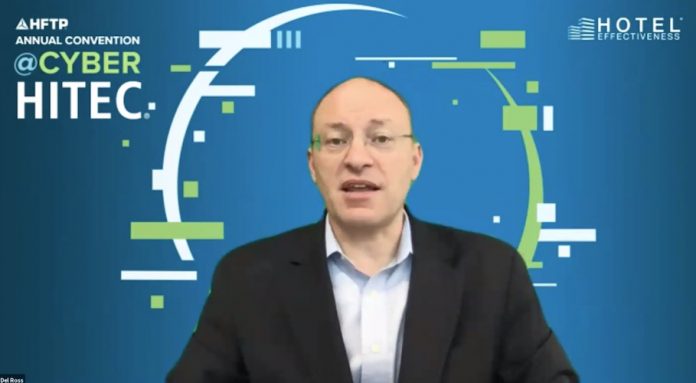
“Labor is an investment and not an expense.” That was among the key themes of a virtual session led by Del Ross, chief revenue officer for Hotel Effectiveness, during CYBER HITEC on October 27, 2020. During the presentation, Ross reviewed traditional methods of labor planning and management and how a more data-driven approach can help hotel owners and operators deliver the same quality service more efficiently to achieve cost savings among other benefits.
“Labor represents the largest share of operating expenses on a regular basis by far,” Ross noted, breaking down labor into three types: Base hours, or the staff necessary to operate the hotel; flexible hours, or staffing driven by factors like occupancy; and extra hours that are devoted to specific investments or areas like preventative maintenance. To treat labor as an investment rather than a cost, hoteliers must define the return on investment, Ross explained. The ROI for labor is productivity rather than direct cash, “although it does lead to cash,” Ross noted. “Your expectations for every dollar that you invest in labor should be outputs measured in productivity. What are the things you’re hoping to accomplish with that labor investment? Every single type of investment requires a different expectation of labor.”
For instance, metrics like minutes per room (MPR), standards for housekeeping and laundry, or even bookings for onsite amenities like spas can be used to measure productivity. Once productivity goals are established for each role, Ross said that operators should measure and track those goals and compare their numbers to a benchmark, whether the performance of a brand, segment, or asset type.
Ross said that traditional binary assessments of labor costs (i.e., staying on budget vs. going over budget) fall short of allowing hotel managers, department heads, and regional operators to hone in on where they can improve. “There is no way to make up yesterday’s excess labor costs by cutting tomorrow’s labor,” he explained.
Having access to data and forecasting tools can give managers the detailed information they need to make better decisions. “If you’re looking at daily, weekly, or monthly forecasts and you’re seeing your actual real-time plus your revised trend forecast for that period, you can make labor plan adjustments at the individual, department, or unit level while things are still happening.” This kind of dynamic labor planning can help hoteliers avoid overstaffing, identify the risk of unnecessary overtime, set goals around productivity to reward performance, and establish meaningful benchmarks to hold managers accountable, ultimately facilitating better conversations around labor management.
In an effort to cut costs, Ross noted that hotels should never sacrifice quality of service or guest experience. “If quality goes down, your reputation goes down, and you can kiss those future guests goodbye because the people who you let down are not going to stay with you again and they’re going to post bad reviews,” he said.
Instead, he suggested rethinking how operators plan for the future by building a zero-base budget—starting from the bottom (i.e., April 2020 when hotels remained open with skeleton crews) and adding costs using standards as the basis for determining the hotel’s labor investment. The bare minimum staffing levels from the early days of the pandemic represent “fixed positions” that a hotel needs on board to operate. Ross added that operators should establish key business drivers, such as occupancy, to determine when to bring back the remaining “variable positions.”
“You actually have a great opportunity to revisit how you determine when you add staff. Do you add more hours to existing staff and incur overtime? Do you bring on contractors? Do you add a part-time person or do you add a full-time person because you know you have enough shift work… you should have a robust and defined decision process for this every single time,” he explained, noting that as hotels grow in the current environment of fluctuating and unpredictable demand, choosing to offer existing employees overtime when business spikes might be ultimately less costly than bringing on additional staff.
Since occupancy volatility is the new normal, the industry needs a labor model to match, Ross said. “If you’re operating in an old-school mindset, you will suffer. It will either take you forever to recover or your recovering will be just part of what it should be. So throw out the old school,” he said. “Everything’s changed—change your model. Go ahead and embrace the standards-based approach, optimize productivity and efficiency, and learn to live with the extra profits and stability.”
Ross conceded that with today’s budget restraints, some owners and operators may be hesitant to overhaul their current models and incorporate new tools and technology. “Everybody’s stretched to the limit today. Budgets are tight. We don’t know what the revenue future’s going to be. The one thing we can count on is it’s uncertain and it’s going to take a while to recover. So taking on a new expense or even a new initiative—whether it comes with an expense or not—is really tricky. The main thing is you have to have confidence that it will pay for itself.”











